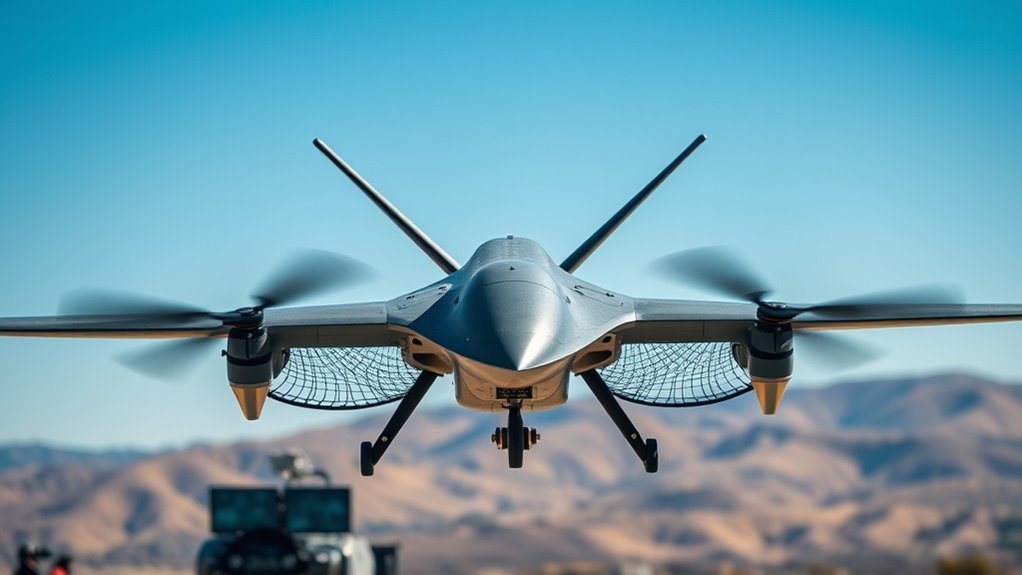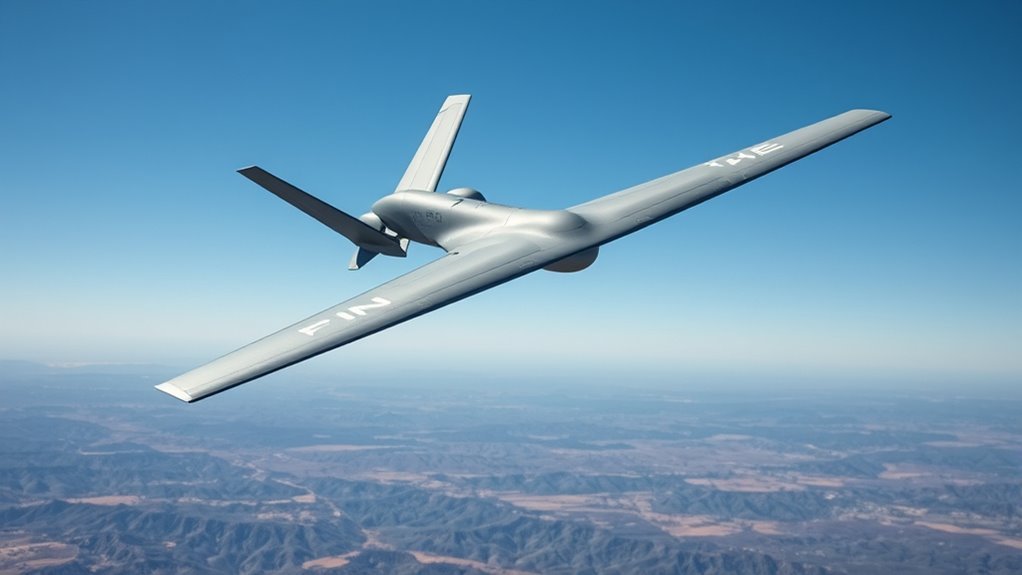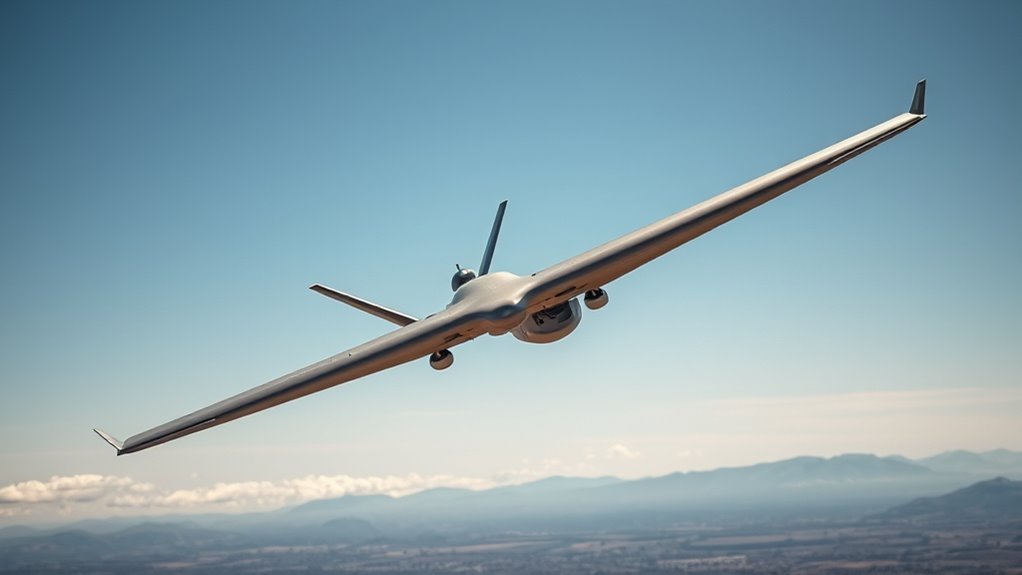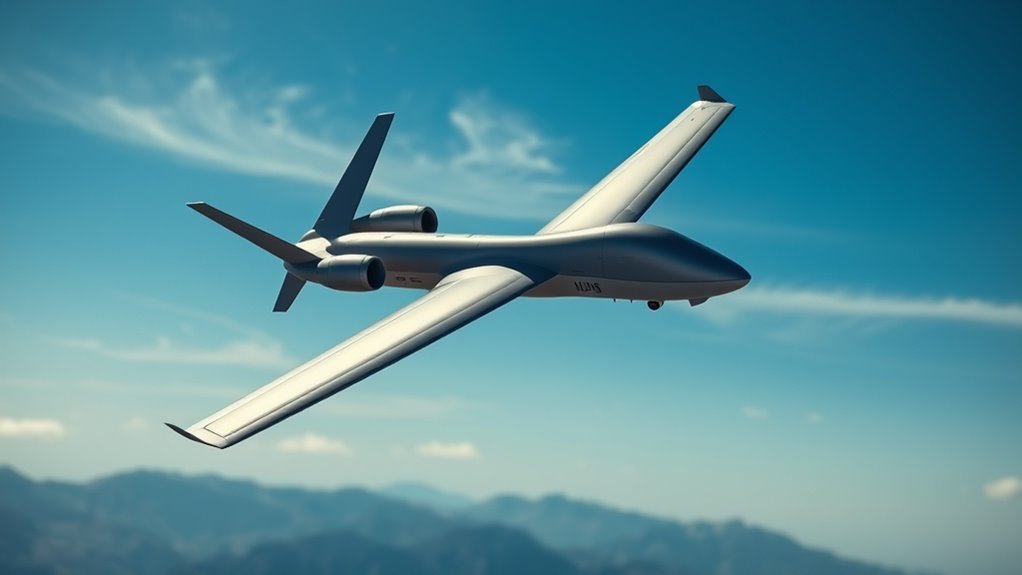The speed of military drones depends on several factors. Engine power and performance affect thrust and acceleration. Aerodynamic design, including wing shape and material, plays an essential role in reducing drag. Considerations of weight and payload influence overall performance, while advanced propulsion systems enhance efficiency. Environmental factors, such as wind and temperature, can also impact flight speed. Understanding these elements is fundamental, and exploring them further reveals their intricate relationships in optimizing drone capabilities.
Engine Power and Performance

When evaluating the speed of military drones, engine power and performance are vital factors that can’t be overlooked. Engine efficiency directly impacts operational range and the ability to sustain high speeds. A drone’s engine must generate sufficient thrust to overcome its weight and drag, allowing it to maneuver effectively. Higher thrust generation often translates to faster acceleration, fundamental for rapid response in dynamic combat scenarios. Additionally, efficient engines enhance fuel consumption, extending mission duration while maintaining speed. As you consider the capabilities of military drones, remember that the balance between thrust generation and engine efficiency is essential for achieving ideal performance and enhancing operational effectiveness. This balance ultimately influences a drone’s strategic advantage in the field.
Aerodynamic Design and Shape

While engine power plays an essential role, the aerodynamic design and shape of military drones greatly influence their speed and overall performance. A well-optimized wing structure is critical for effective lift and maneuverability. Streamlined shapes reduce drag, allowing drones to cut through the air more efficiently. Features like swept wings or canards aid in minimizing turbulence, enhancing stability and speed. By focusing on drag reduction, engineers can considerably improve a drone’s operational range and response time. Additionally, the materials used in construction can further enhance aerodynamic capabilities, ensuring that drones maintain high speeds without compromising their structural integrity. Ultimately, a meticulous approach to aerodynamic design is fundamental for maximizing the effectiveness of military drones in the field.
Weight and Payload Considerations

When considering military drone speed, weight and payload are critical factors that directly influence performance. The drone’s design specifications dictate its payload capacity, which can greatly impact its overall agility and speed. Balancing these elements is essential for optimizing operational effectiveness while maintaining the required capabilities.
Drone Design Specifications
Although the design specifications of military drones considerably influence their operational efficiency, weight and payload considerations are among the most critical factors affecting speed. You’ll find that the choice of drone materials plays a pivotal role; lightweight composites or advanced alloys can drastically reduce overall weight, enhancing speed. Design innovations, such as streamlined aerodynamics and optimized propulsion systems, further help mitigate drag and improve performance. However, while lighter materials can boost speed, they must also accommodate the necessary payload without compromising structural integrity. Balancing these elements is essential for achieving the desired operational capability. Ultimately, understanding how weight and payload integrate with design specifications can empower you to appreciate the intricate dynamics of military drone performance.
Payload Capacity Impact
Payload capacity greatly influences a military drone’s speed and overall performance. When you consider the weight of the payload, it directly impacts the drone’s thrust-to-weight ratio. A heavier payload can reduce speed and maneuverability, necessitating effective payload optimization strategies. This involves selecting the right equipment and materials that maximize capability without compromising speed.
In your mission efficiency analysis, you’ll find that balancing payload weight with speed requirements is essential for operational success. By carefully managing the payload, you can enhance endurance and range while maintaining swift response times. Ultimately, understanding these dynamics allows for strategic planning, ensuring that missions are executed effectively and with the agility needed in modern warfare.
Propulsion Systems and Technology
As advancements in propulsion systems continue to evolve, military drones are becoming faster and more efficient. The core of these improvements lies in enhanced propulsion efficiency, which directly influences speed and operational range. By integrating cutting-edge technology advancements, manufacturers are optimizing engine designs and fuel types, allowing drones to achieve higher thrust-to-weight ratios. Electric and hybrid propulsion systems are gaining traction, offering quieter operation and reduced thermal signatures while minimizing energy consumption. These innovations not only boost speed but also extend mission durations, ensuring drones can cover greater distances without frequent refueling. Ultimately, by leveraging advanced propulsion technologies, military drones are positioned to enhance tactical capabilities, providing greater freedom in strategic operations.
Environmental Factors and Conditions
When considering military drone speed, environmental factors play a critical role in performance. Wind speed can greatly affect flight stability and speed, while temperature variations impact engine efficiency and lift. Additionally, atmospheric pressure influences the drone’s aerodynamic characteristics, requiring adjustments to maintain ideal speed.
Wind Speed Impact
Although military drones are designed for high performance, their speed can be greatly affected by wind conditions. When flying against strong winds, you’ll notice increased wind resistance, which can considerably reduce the drone’s effective speed. Conversely, tailwinds can enhance speed, but they may also compromise flight stability, making the drone more susceptible to sudden gusts. It’s vital to take these factors into account during flight planning, as unanticipated wind conditions can lead to navigational errors or mission failures. Balancing speed with stability is fundamental; otherwise, the drone may face operational challenges. By understanding wind impacts, you can better optimize flight paths and guarantee mission success while maintaining operational freedom in dynamic environments.
Temperature Effects
Wind conditions aren’t the only environmental factor that influences military drone performance; temperature also plays a significant role. Temperature variations can directly affect engine efficiency and aerodynamic properties, which in turn impacts flight speed. Warmer temperatures can reduce air density, potentially allowing for higher speeds, while colder temperatures may increase drag and slow the drone down. Understanding the climate impact on flight operations is essential for mission planning.
| Temperature Range | Effect on Speed | Notes |
|---|---|---|
| Below 0°C | Decreased speed | Increased air density |
| 0°C – 25°C | ideal performance | Balanced conditions |
| Above 25°C | Potentially increased speed | Reduced air density |
Atmospheric Pressure Influence
As atmospheric pressure decreases, the performance of military drones can be considerably impacted, affecting their speed and operational effectiveness. At higher altitudes, pressure variations reduce air density, which in turn influences lift and thrust generation. You’ll notice that drones may require more power to maintain speed and altitude in such conditions. The altitude effects become pronounced, as engines may struggle to achieve peak performance, potentially leading to decreased flight stability. Additionally, the drone’s aerodynamic efficiency can be compromised, making it harder to navigate in lower pressure environments. Understanding these dynamics is essential for mission planning, ensuring that your drone operates effectively, regardless of atmospheric pressure changes encountered during flights.
Mission Objectives and Operational Requirements
When mission objectives dictate the operational tempo of military drones, speed becomes a critical factor in achieving success. The complexity of the mission directly influences the required operational strategy. High-stakes scenarios often necessitate rapid response times, compelling you to maximize drone speed. Conversely, missions with lower urgency can afford slower speeds, prioritizing surveillance or data gathering over haste.
Operational requirements, such as payload capacity and operational range, also play a pivotal role. You’ll need to balance the drone’s speed with its ability to complete the mission effectively. Ultimately, understanding how mission complexity shapes your operational strategy is essential for optimizing drone performance and ensuring mission success while maintaining the freedom to maneuver effectively in dynamic environments. Additionally, real-time data transmission supports rapid decision-making, further emphasizing the importance of speed in tactical operations.
Frequently Asked Questions
How Do Pilot Skills Influence Drone Flight Speed?
Your pilot skills greatly impact drone flight speed. Advanced pilot training and higher experience levels enable quicker, more precise maneuvers, optimizing speed and efficiency. Mastery in controlling variables enhances overall performance in various operational environments.
What Role Does Maintenance Play in Drone Performance?
Think of maintenance as the oil that keeps your machine running smoothly. Adhering to maintenance protocols guarantees performance optimization, allowing drones to reach their full potential and enhancing reliability, ultimately shaping operational success in the field.
Are There Regulations Affecting Military Drone Speeds?
Yes, there’re regulations impacting military drone speeds. Speed restrictions and operational guidelines are often in place to guarantee safety, compliance with airspace rules, and to maintain strategic advantages while balancing operational effectiveness and mission objectives.
How Do Different Terrains Impact Drone Flight Speed?
When you navigate various terrain types, like flat plains versus rugged mountains, you’ll notice elevation changes considerably affect your drone’s flight speed. Thicker air at higher altitudes can slow you down, impacting overall efficiency.
What Technological Advancements Are Improving Drone Speeds?
Technological advancements like autonomous navigation systems and advanced materials are enhancing drone speeds. These innovations optimize flight efficiency and reduce weight, allowing you to achieve greater velocities while maintaining stability and control during missions.

